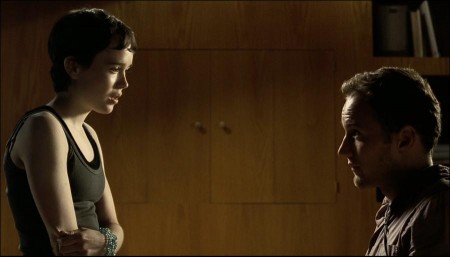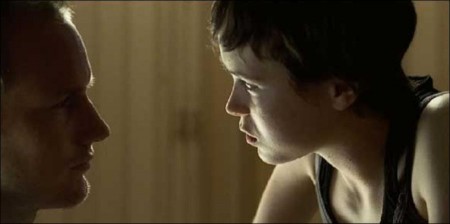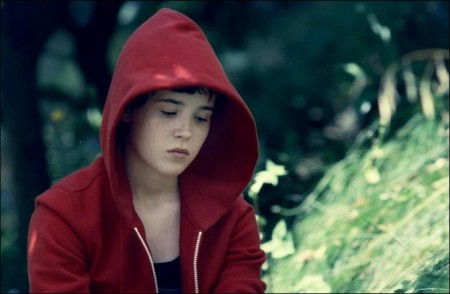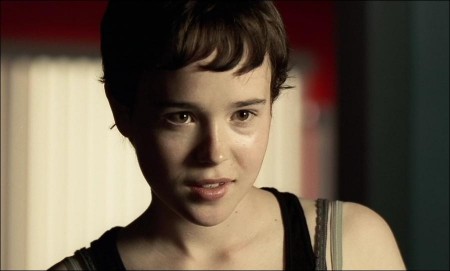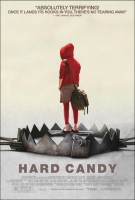A smart, charming teenage girl, Hayley probably shouldn’t be going to a local coffee shop to meet Jeff, a 30-something fashion photographer she met on the Internet. But before she knows it, she’s mixing drinks at Jeff’s place and stripping for an impromptu photo shoot.
It’s Jeff’s lucky night. But Hayley isn’t as innocent as she looks, and the night takes a turn when she begins to impose a hard-hitting investigation on Jeff in an attempt to reveal his possibly scandalous past. Hard Candy is an edge-of-your-seat psychotic thriller.
Hayley’s a smart, charming teenage girl — but even smart girls make mistakes. She’s hooking up in a coffee shop with Jeff, a guy she’s met on the Internet. And even though he’s a cute, smooth high-end fashion photographer in his early 30s, Hayley shouldn’t be suggesting that the two of them go back to his house — alone. When they get there, Hayley quickly finds some vodka and starts mixing screwdrivers. She even suggests a photo shoot and strips off some clothing. Everything is going well for Jeff… until his vision blurs and fades, and he passes out.
It turns out Hayley has spiked Jeff’s screwdriver, and when he revives, he’s tied down with Hayley searching through his place. She doesn’t think it’ll take too long to get a confession that she’s not the first teenage girl Jeff’s brought home and, more importantly, that her prisoner knows what happened to Donna Mauer, another girl who disappeared from Jeff’s favorite coffee shop. And if he’s unwilling to confess, well, she has another plan –She uses an icepack as a homemade anesthetic… She starts shaving an incision site… She’s learned a lot from the internet — including this little surgical procedure she’s dying to try…
About the Production
A cat-and-mouse psychotic thriller as incisive as it is stylish, Hard Candy delivers a provocative take on the revenge drama while jangling the nerves at every turn. Directed by innovative music video and commercials director David Slade and written by accomplished playwright Brian Nelson, Hard Candy plunges us into an unstable universe where we cannot readily identify the “good guy” in the tense confrontation between a 14-year-old girl and the 32- year-old man she suspects of pedophilia and murder.
Rather, the film introduces us to two intelligent, strong-willed individuals who are engaged in a battle of wits – a battle in which it is unclear who is telling the truth. Adding fuel to the film’s fire are the powerhouse performances of its two stars, the young Canadian actress Ellen Page and acclaimed stage and screen actor Patrick Wilson (Angels in America).
As the adolescent avenger Hayley Stark, Page invests her 14-year-old character with all the passion, certitude and coltish charm of the age, while Wilson’s subtle interpretation of photographer Jeff Kohlver draws us to his character even as his behavior remains open to speculation. Making his feature debut, director Slade makes deft use of color, sound, texture, intimate close-ups and editing to ratchet up tension and illuminate character, making Hard Candy a thriller that stimulates the emotions and the senses alike.
The initial inspiration for Hard Candy was a spate of real-life attacks that took place in Japan. Producer David Higgins read about the cases, in which schoolgirls turned the tables on older men trolling the Internet for underage dates. After one girl established an online relationship with a man, she and her friends would ambush him at a pre-arranged rendezvous.
Higgins began mulling over the dramatic possibilities inherent in the story. “It opened an interesting and different perspective on who was the predator and who was the prey,” the producer recalls. “Then I thought: what if it was just one girl going after Internet predators? I’d never seen a movie about a 14-year-old vigilante do-gooder.”
Higgins imagined a minimalist setting for the story, with two characters confronting one another in a strictly defined space. Such a film would be a psychological study as well as a thriller, and the creation of multidimensional individuals was uppermost in Higgins’s mind when he approached playwright Brian Nelson about writing the screenplay.
Explains Higgins, “It’s nice to have the concept, but it’s the execution that matters — and that’s why I wanted to work with a playwright. I needed somebody who could write character, and not just plot. With two people in a room, there are no car chases and nothing to fall back on except character. I’d read one of Brian’s plays, and knew he’d be perfect.”
A leading figure in Los Angeles theatre, Nelson is a co-founder of the David Henry Hwang Writers Institute and an award-winning stage director. Nelson’s plays are largely driven by character, and he recognized that the movie Higgins outlined to him demanded the same approach. “The heart of this piece would be in the duel between two opponents who only seem mismatched at first,” affirms Nelson. “The opportunity to write a two-character duel in the vein of Misery, Sleuth, and Oleanna was too interesting to pass up. And coming from theatre, where there are always more talented actresses than there are roles, how could I resist the chance to create a unique heroine like Hayley?”
Nelson and Higgins spent two months fleshing out the story to their mutual satisfaction, after which Nelson began work on the screenplay. From the characters’ first meeting in a coffee shop called Nighthawks, the story sets up an atmosphere of erotic tension as 32-year-old Jeff and 14-year-old Hayley trade suggestive banter. As a photographer whose work regularly brings him in contact with beautiful teenage girls, Jeff seems to know just the right things to say to Haley, who is by turns bold and awkward as she tries on the role of sexual sophisticate. It is only later that it becomes clear that both Hayley and Jeff have arrived at Nighthawks with hidden agendas.
As the drama unfolds, they continue to play their cards close to their vests. In creating evenly matched characters, Nelson drew upon his own experience as a chess player. “It’s hard to find people to play chess with, so I got used to playing both sides of the board,” the writer explains. “Asking yourself the best move you can make against yourself is, I think, invaluable training for writing two characters who are both at the top of their game, who are involved in a life-or-death duel.”
Nelson’s experience teaching theatre at high school and college levels helped inform his conception of whip-smart 14-year-old Hayley. Says Nelson, “Most of my theatre students are female, most of them are brilliant, and most of them are wrestling with a world that is fundamentally unfair. I wanted to make Hayley as bright and funny and inventive as my best students have always been.”
Hayley also possesses an unwavering belief in her mission and in herself; it is with that sense of conviction that she sets out to trap a man she is convinced is a killer. As Nelson notes, “It’s no coincidence that the script references Jean Seberg, who played Joan of Arc — a woman who took on forces far bigger than she should have been able to handle.
The attractive, likeable Jeff hardly fits the image of a pedophile/killer. But Nelson points out that an appealing personality is unreliable indicator, at best. “As Hitchcock said, if a villain is too scary, how would he get close to any of his victims?,” the writer remarks. “Jeff is bright, charming, successful: who wouldn’t be happy to spend time with him? But the power of teenage girls, on whose personalities and bodies his photography depends, unsettles him so deeply that he’s got to cage that power before he feels overwhelmed by it. Jeff has masked from himself the full extent of his deviance — until Hayley becomes the crisis that faces him with his true self.
Once the final screenplay was completed, the search began for a director to bring Hard Candy to the screen. Filmmaker David Slade, whose striking music videos and commercials have placed him much in demand, finished the script in one sitting. “I just couldn’t stop reading it,” Slade recalls. “It made me question my own prejudices, and made me do a lot of thinking. Where do you draw the line between what’s acceptable and what isn’t? Where do you draw the line between what’s acceptable pornography and what isn’t? Where do you draw the line between voyeurism and just plain looking?”
The cinematic possibilities offered by the story also piqued Slade’s imagination. A former journalist, fine artist and photographer, Slade is a great admirer of the early films of Nicolas Roeg, the cinematographer-turned-director of Performance and Don’t Look Now. “Those films were realistic portrayals of, and investigations into, relationships that go sour but continue. The other thing about Roeg is that his background as a cinematographer gave him a very clear understanding of how form can powerfully impact upon the characters and the narrative of a film. With Hard Candy, there was a compelling story and compelling characters, and the opportunity to use form to heighten the tension and drama of the situation.”
A single meeting was all it took to convince producer Higgins that Slade was the perfect choice to helm Hard Candy. “David’s videos and commercials are amazing. You look at his reel and it’s clear that he could make toast look interesting. Yet where other directors talked only about visuals, David’s first forty-five minutes of conversation with me were all about the script, the story, the characters,” the producer recalls. “All his notes were right on. He got the story, he knew who the characters were, and he wanted to make the movie Brian and I wanted to make.”
Higgins found like-minded production partners at Vulcan Productions, the Seattle-based company whose credits include Far From Heaven and Titus. The company’s Richard Hutton and Michael Caldwell joined Higgins as producers on the film. “We’re interested in films that have a strong artistic sensibility,” says Hutton. “With Hard Candy, we loved the script, and we thought David Slade was extraordinarily gifted and had a wonderful vision for what the film could be.”
As the casting process began, the filmmakers decided to first direct their efforts towards finding an actress to portray Hayley. They expected the female lead to be the more difficult role to cast, and they were not wrong. Slade estimates that between 250 and 300 young actresses read for the part. Then he watched a video, submitted in MPEG format, of a young Canadian actress, Ellen Page.
“It was a terrible quality MPEG. Ellen had recently shaved her head for a role, so for all intents and purposes I was looking at this little boy doing this reading without any direction at all,” Slade recalls. “Yet she was head and shoulders above everybody else we’d seen at that point. She was just raw ability, and very passionate and articulate; she emotionally believed the character. Ellen was the choice.”
Page was impressed by the authenticity of Haley’s voice in the script. “You don’t usually come across a 14-year-old girl written so well,” she remarks. “Hayley had so many layers, and was so passionate. I was excited to get into her head.”
Patrick Wilson, the much-lauded theatre actor who shot to national attention with his Emmy Award-nominated performance in Angels in America, was cast as Jeff. Notes Slade, “Patrick comes from the theatre and so I knew he was going to act 100% of the time and not wait for a close-up. I thought he was phenomenal in Angels in America; you could see he has tremendous range. Patrick was uncomfortable with the amount of sexual flirtation in the first meeting between Hayley and Jeff, which is a testament to what a nice guy he is. But that also made me think, ‘Great! I can play off that.’”
Wilson appreciated the ambiguity that fueled the story. “What’s interesting is that the film doesn’t really define who is the good character and who is the bad character,” the actor notes. “Obviously, there’s the predator and the prey. The exciting thing for me as an actor is that those roles switch constantly. It’s certainly not what you expect from that first scene of Jeff and Hayley in the coffee shop.”
Slade mapped out every detail of the film well in advance of production, and called upon the expertise of several former collaborators. Some of the most esteemed talents from the commercial and video worlds joined Slade for the production, including director of photography Jo Willems and production designer Jeremy Reed.
Part of the director’s strategy was to stage the narrative with discrete yet powerful elements. Explains Slade, “We created a very strict vocabulary for the filmmaking. The color palette of the film, and the tone and the density were all planned beforehand. The color was like a third character in the film, and it was going to do a lot of storytelling when very little was being said and very little was being done. The sound design was indexed to each of the characters; we had four different sound design modes for Hayley, depending on what mood she was in. We had audio cues and color cues that were to underscore a character’s subconscious feelings.”
Production on Hard Candy took place during 18 days in June 2004 in Los Angeles. Jeff’s house was constructed on a soundstage, and the layout was partially based on producer David Higgins’s own modernist home. With the exception of the coffee shop scene, all the action was filmed entirely in sequence.
Shooting in sequence allowed Wilson and Page to complete their most physically demanding scenes in a certain number of days, knowing that relief was on its way. Both actors performed their own stunts, rigorously supervised by stunt coordinator Erick Brennan. The demands were particularly great on Wilson, who spends much of the film tied up, not to mention beaten and stunned by a Taser. The Taser was live, though the batteries had been removed. “We were working in completely safe, supervised conditions. Still, it was nervewracking,”
Slade remembers. “The noise that thing makes on the screen is nothing compared to the noise in the room when you stand next to it. Whenever there’s a blue spark, that isn’t the post-effects – it’s real.”
Slade credits the actors for creating Hayley and Jeff as individuals who cannot be readily identified as either hero or villain. “Neither of those characters are good characters,” allows Slade. “Neither of them are archetypes, and they defy expectations as a result of that. These characters are grounded in a reality, in the way they talk and the way they act. And the compelling performances by Ellen and Patrick further ground it in reality.”
Comments Page, “The whole concept of good versus bad is askew in this movie. Brian Nelson and David Slade created an atmosphere where one moment you feel sympathy for a character and the next, utter hatred.”
Page was just 17 when the film was shot, and Slade reports that she brought intense dedication as well as artistry to her work. “Give Ellen one little note about how important a single word is in an entire scene, and she can create a whole performance around that one word,” marvels Slade. “She would go away and work on that, and come out with something that made your spine tingle.”
He is equally admiring of Wilson. “For Patrick, there were a lot of questions about how to play a given moment. In a number of instances, his instincts were different than mine and in a number of those instances his choice was better. His physical acting is amazing.”
Wilson feels Hard Candy functions as both psychotic thriller and psychological drama. “This film succeeds in creating a very creepy realism,” he remarks. “People can watch and on some level they can see aspects of themselves, aspects of people they know. And that’s compelling — and also disturbing.”
Screenwriter Nelson was impressed by how Page and Wilson captured the relationship that develops between Hayley and Jeff, and a dynamic that ultimately transforms them both. “It’s only because they get close that Hayley and Jeff can really hurt each other,” Nelson affirms. “I’m so delighted with how Ellen and Patrick captured the charm of these characters, and their ferocious determination to protect what they care about, at all costs.”
Hard Candy had its premiere at the 2005 Sundance Film Festival, where it provoked heated discussion, as audience members debated issues from Jeff’s guilt or innocence to Hayley’s motivations. Higgins allows that a certain degree of ambiguity was one of the filmmakers’ goals.
“We didn’t want to give the audience a pat ending and wrap it all up. Let the audience decide for themselves: Who is Haley and why did she do this? Did the characters get what they deserved? Those are things I’d love to have an audience arguing about when they leave.”
Director Slade shares that hope. “I think we’ve managed to make a film that people can see and then talk about a subject that is very difficult to see in a film and talk about,” he says. “It’s a film you go and experience. Yes, it’s a thriller — and I hope that it will thrill an audience and then makes them think for a few days.”
These production notes provided by Lionsgate Films.
Hard Candy
Starring: Patrick Wilson, Ellen Page, Sandra Oh, Jennifer Holmes
Directed by: David Slade
Screenplay by: Brian Nelson
Release Date: April 14th, 2006
MPAA Rating: R for disturbing violent and aberrant sexual content involving a teen, and for language.
Studio: Lionsgate Films
Box Office Totals
Domestic: $1,024,640 (14.6%)
Foreign: $5,997,569 (85.4%)
Total: $7,022,209 (Worldwide)

